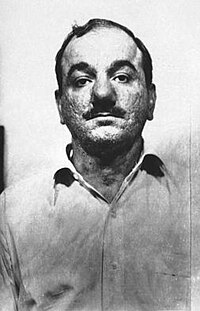Philip Testa
This article needs additional citations for verification. (December 2010) |
Philip Testa | |
|---|---|
 Testa's 1956 PPD mugshot | |
| Born | Philip Charles Testa April 21, 1924 Philadelphia, Pennsylvania, U.S. |
| Died | March 15, 1981 (aged 56) Philadelphia, Pennsylvania, U.S. |
| Cause of death | Bombing |
| Resting place | Holy Cross Cemetery, Yeadon, Pennsylvania, U.S. |
| Other names | "The Chicken Man", "The Julius Caesar of the Philadelphia Mob", "Philly" |
| Occupation | Crime boss |
| Spouse | Alfia Arcidiacono |
| Children | Salvatore and Maria |
| Allegiance | Philadelphia crime family |
Philip Charles Testa (April 21, 1924 – March 15, 1981), also known as "The Chicken Man", was an American mobster known for his brief leadership of the Philadelphia crime family. He became boss after Angelo Bruno was murdered by his own consigliere, Antonio Caponigro, who, in turn, was ordered killed by The Commission for acting without permission. Testa's nickname came from his involvement in a poultry business. About a year after Bruno's death, Testa was killed by the blast of a nail bomb allegedly ordered by his underboss, Peter Casella.
Early life
Testa was born to Sicilian immigrants in Philadelphia, Pennsylvania, and lived in South Philadelphia with his family in his teenage years. In South Philadelphia he met and befriended future mob boss Angelo Bruno. He later married Alfia Arcidiacono (records show her family owned a farm in Salem County, New Jersey). In early police dossiers on Testa, he was identified by law enforcement as not having a legitimate source of income and was solely dependent from winnings as a "common gambler."
Testa and his wife had a son who also became involved in organized crime, Salvatore Testa, and was killed three years after his father.[1]
In 1970, Testa became underboss of Angelo Bruno. When Bruno was murdered in 1980, Testa became boss, appointing Nicodemo Scarfo as consigliere.
Death and aftermath

One month before Testa was murdered, he, Frank Narducci Sr., Harold and Mario Riccobene, Pasquale Spirito, Joseph Ciancaglini, and several associates were indicted in a federal racketeering case that centered on gambling and loansharking operations run by the mob. The case was based on an investigation called Operation Gangplank and was one of the first built on the RICO Act by the U.S. Attorney's Office in Philadelphia. On March 15, 1981, Testa returned to his home in South Philadelphia that was across the street from Stephen Girard Park. As he was opening the door to his twin home at 2117 Porter Street, a nail bomb exploded under his front porch.[2] His death was allegedly ordered by his underboss and drug trafficker Peter Casella and capo Frank Narducci Sr., which later resulted in Narducci being gunned down and Casella being banished from the Mob and fleeing to Florida.
Testa's murder sparked a war within the family. Scarfo seized the top position for himself, promoting his nephew Phil Leonetti as his underboss and Frank Monte as his consigliere.[3][4] Scarfo would go on to lead the family for a decade with a bloody rampage, fueled by paranoia and aggression.[5]
In popular culture
Testa's violent death is referenced in the opening lines of musician Bruce Springsteen's song "Atlantic City".[6]
See also
References
- ^ Upi (1984-09-21). "Salvatore Testa, Buried; Reputed to Be Crime Leader". The New York Times. ISSN 0362-4331. Retrieved 2020-04-15.
- ^ Capuzzo, Michael (2010). The Murder Room: The Heirs of Sherlock Holmes Gather to Solve the World's Most Perplexing Cold Cases. New York City: Gotham Books. p. 189. ISBN 978-1592401420.
- ^ "This Mob Shot Its Brains Out Crime boss Ralph Natale, in rare testimony against his own, tells a tale of murder--and ineptitude". The Los Angeles Times. Tribune Media Services. May 4, 2001. Retrieved 10 March 2016.
- ^ "Mob Violence Is Personal For Narducci's Sons". Philly.com. Retrieved 10 March 2016.
- ^ "The Mafia Prince Next Door". Huffington Post. New York City: Huffington Post Media Group. December 11, 2016. Retrieved March 10, 2016.
- ^ Beviglia, Jim (2014). Counting Down Bruce Springsteen: His 100 Finest Songs. Rowman & Littlefield. p. 161. ISBN 978-1-4422-3066-8. Retrieved 21 January 2021.
Further reading
- Anastasia, George (2004). Blood and Honor: Inside the Scarfo Mob - The Mafia's Most Violent Family. ISBN 0940159864.
External links
- 1924 births
- 1981 deaths
- American mob bosses
- American mobsters of Sicilian descent
- Deaths by improvised explosive device in the United States
- Murdered American mobsters of Italian descent
- Murdered American mobsters of Sicilian descent
- People murdered by the Philadelphia crime family
- People murdered in Pennsylvania
- Philadelphia crime family
- Unsolved murders in the United States
- Burials in Pennsylvania
